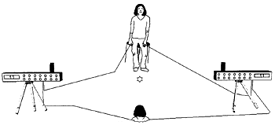SYSTEM FOR THE KINETIC MEASUREMENT OF THE PERIPHERAL VISION AND THE PERIPHERAL VISUAL ANTICIPATION
|
Description |

Representation of the evaluation system with the evaluated person holding two buttons, one in each hand, and another two for the examiner, who emit the signals for the test
We present a device in the form of a bar and a system for the kinetic measurement of peripheral vision and peripheral visual anticipation. It consists in determining when the visual stimulus appears in the peripheral visual field and in estimating the appearance of it in a point, recording anticipation or procrastination, using two equal and symmetrical bars in which rows of LED lights of different colors are lit following an order. It allows determining both measures in situations close to the reality of work or play with illuminations similar to environmental ones.
|
How does it work |
The seated person sits between the two symmetrical and equidistant bars, at a certain distance from them. The bars are level at eye level. The person fixes his sight on a central point located at a certain distance, in such a way that the position of head or eyes cannot vary. With two push buttons, one connected with each bar.

Elevation of the measurement bar. 1. White LEDs, 2. RGB LEDs, 3. Display, 4. Visual peripheral preview control
The optician-optometrist or professional in charge activates the sequence of lights chosen through two other buttons, turning on successively the rows of lights, sometimes of the right bar and sometimes of the left, sometimes the white lights and sometimes the three-colored ones, but in a single prefixed color.
The lights of the rows are lit from the farthest to the nearest. That is, from the periphery of the visual field to the fixation point of the view and simulating the movement of the stimulus along the lateral as a moving object.
The examinee will indicate when he or she perceives the visual stimulus, pressing the corresponding bar's pushbutton for the kinetic measurement and visual anticipation evaluations.
A screen will reflect the time elapsed from the ignition of the row of LED chosen until the examinee can see the stimulus, allowing the examiner to evaluate the measurements at different speeds, with several colors and being able to evaluate the anticipation of the stimulus in ms.
|
Advantages |
-The sports coaches can check the shortcomings of players in their squad, displacing them from their position when necessary and take more advantage of the play area where their peripheral visual field is more effective, given the physical and tactical characteristics of the athlete of value, deficient in an incorrect position.
-Improving the vision assessment drivers who have concentrated sight at a point for their work. They can suffer variations of the environment, that on the road you can cross any object in a surprising way, or that there are important lateral movements that can endanger the activity of any person or active worker.
-It can be used as a subjective test of peripheral vision evaluation in the open field. In this way, measures closer to the natural conditions of work or play are achieved.
|
Where has it been developed? |
The design and its prototype have been developed in the Faculty of Optics and Optometry. This invention is protected by a national patent with previous examination since 2011.
|
Contact |
|
© Office for the Transfer of Research Results – UCM |
|
PDF Downloads |
|
Classification |
|
Responsible Researcher |
Ricardo Bernárdez Vilaboa: rbvoptom@ucm.es
Department: Optometry and Vision
Faculty: Optics and Optometry


